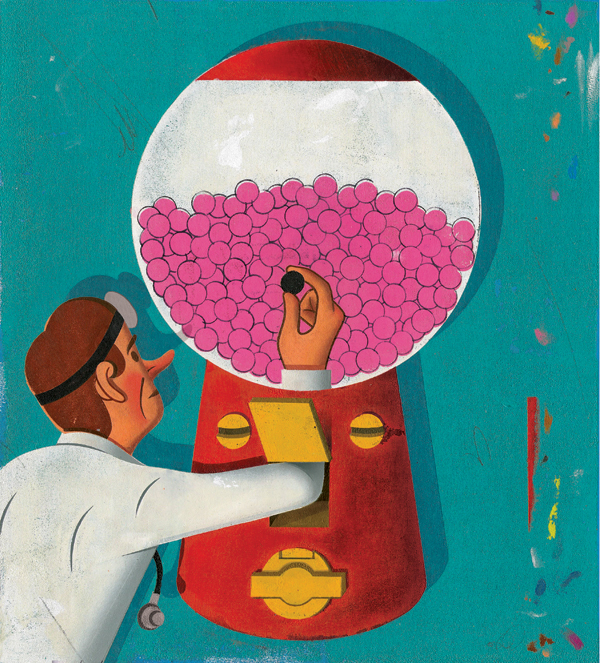Philip Theodosopoulos: In terms of sinus surgery, even 10 years ago you couldn’t do most of what we do now. The old way involved opening the skull and sometimes breaking the jawbones to get to tumors.
Lee Zimmer: Now the process is much less invasive. For example, for a pituitary tumor we start by looking into the nose with a 4 mm diameter endoscope and watch the feed on an HD TV. We then find small openings in the sphenoid sinus wall [a paper-thin bone] and open that. We remove a little bit of the partition, or septum, deep in the nose. It’s then that we can see the tumor, and being careful not to nick the optic nerve or carotid arteries, we remove it. We don’t have to touch or move the brain at all. With the old way, we’d also have to put 10 yards of gauze up the patient’s nose to keep the surgical site sealed off so it could heal properly. That’s very painful to remove. Now, we simply seal off the surgical site with a gel spray and a small piece of fat from the patient’s belly.
Theodosopoulos: There used to be a lot more side effects too, including infection, pain, and scarring. The difference between the old approach and what we do today is honestly night and day. This isn’t only a better technique for surgeons; it’s producing better outcomes for the patients. It’s less risky and there’s no morbidity. That’s huge.
Zimmer: We’re able to look at more quality of life issues for the patient, too. We’re able to remove the tumor without affecting their sense of smell, and they wake up the next day able to breathe and go home.
Theodosopoulos: And psychologically, how you feel about your healing process has a big impact on your recovery. I’ve actually had patients come to me and say, “Doc, you’re sure you actually performed surgery on me, right?” I have to show them before and after scans to prove it to them. They can’t believe they feel as good as they do. Brain surgery is a major life event, and to feel normal afterward—you know that you’re winning.
Zimmer: I think it also has to do with the team-oriented approach. At the UC Neuroscience Institute, we have a tumor board where every patient is presented. At that tumor board we have radiation oncology, medical oncology, radiology, neurosurgery, ENT, pathology, endocrinology, and sometimes ophthalmology, so you have a wide scope of functions tailoring a patient’s treatment. That’s what makes UC special. You get the whole team’s expertise.
Theodosopoulos: It gives the patient hope. We don’t punt them somewhere else—the buck stops with us. If you come to us, we own your care. Very few people do the number and quality of tumors that we do here. We do 150 to 200 tumors a year, and I just did my thousandth tumor last week. There are years Lee and I do more tumors than the Cleveland Clinic altogether.
Zimmer: We’re still learning—it’s a continuum of improvement—but really, you don’t have to travel to get good care.
Originally published in the January 2012 issue.





Facebook Comments